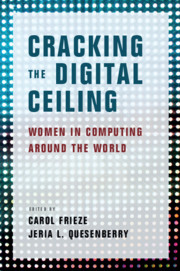Book contents
- Cracking the Digital Ceiling
- Cracking the Digital Ceiling
- Copyright page
- Contents
- Contributors
- Acknowledgments
- Introduction
- Part I Global Perspectives
- 1 An Inegalitarian Paradox
- 2 A Global Perspective on Women in Information Technology
- 3 Field Studies of Women in Europe, North America, Africa, and Asia-Pacific
- Part II Regional Perspectives
- Part III Cultural Perspectives from the United States and Europe
- Part IV Cultural Perspectives from Asia-Pacific
- Conclusion
- Notes
- Index
- References
1 - An Inegalitarian Paradox
On the Uneven Gendering of Computing Work around the World
from Part I - Global Perspectives
Published online by Cambridge University Press: 10 October 2019
- Cracking the Digital Ceiling
- Cracking the Digital Ceiling
- Copyright page
- Contents
- Contributors
- Acknowledgments
- Introduction
- Part I Global Perspectives
- 1 An Inegalitarian Paradox
- 2 A Global Perspective on Women in Information Technology
- 3 Field Studies of Women in Europe, North America, Africa, and Asia-Pacific
- Part II Regional Perspectives
- Part III Cultural Perspectives from the United States and Europe
- Part IV Cultural Perspectives from Asia-Pacific
- Conclusion
- Notes
- Index
- References
Summary
Previous research has revealed surprising cross-national differences in the gender composition of information and communication technology (ICT) fields. In 2001, for example, women’s representation in ICT degree programs was weakest in the world’s most affluent and reputably gender-progressive societies (Charles and Bradley, 2006). Historical trends in the ICT sectors of affluent democracies seem, moreover, to have gone in the direction of more, not less, gender segregation. Despite dramatic increases in female labor force participation and university attendance, US women’s share of bachelor’s degrees in computer science decreased from 28% to 18% between 2000 and 2015 (NSF, 2018, appendix 2-21), with similar declines documented in Europe for the 1990s (Schinzel, 2002).
- Type
- Chapter
- Information
- Cracking the Digital CeilingWomen in Computing around the World, pp. 25 - 45Publisher: Cambridge University PressPrint publication year: 2019
References
- 9
- Cited by



